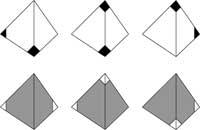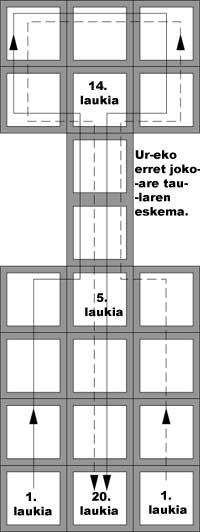The water game

The greatest treasure of ancient art objects in Mesopotamia (today Syria and Iraq), between the Tigris and Eufrate rivers, is due to the expedition led by Sir Leonard Woolley. The discovery dates from the second decade of this century, in which the British Museum and the University of Pennsylvania participated. The greatest achievement of the expedition are the royal tombs of Ur. Among the many treasures that were published were extensive game tables. The discovery of these objects of 4,500 years had a great archaeological value, since they were the oldest game boards that had been found to date.
The game was of great prestige among the main classes of Sumer, since the tables were found only in the tombs of the royal house and the rich. As was customary at this time, the deceased left ladies' tables in their tombs to help spend pleasant moments in the world of the ultramarine.
Some game tables found in Ur had a special decoration. One of them had shells cracked with blue lapis and lime stones. Other times, drawings of animals appear on shell plates. Next to the game tables were found two types of tiles. The white part has five dark points and the black part five clear points. Next to the tiles were found six data of four singular sides: they have a pyramidal shape and two of its four vertices are of marquetry. Three data are white and three in color lapis lazuli. This makes us think that they are data for the two players.

The picture table is a copy of the original table of the British Museum in London. With this game they found two types of tiles: some mother-of-pearl with blue lapis points and others slate with mother-of-pearl points.
Today it is known as Real Game of Ur. Backgammon is considered to be the antecedent of harassment games in the team. As has happened on many other occasions, no written standard has been kept either. However, tables and other tracks have allowed to reconstruct the game rules.
Rules of the Royal Game

Each player has seven tiles and three data. The data are tetrahedra, that is, they have four sides and four vertices. Two of the four vertices are marked. The three data are released at the same time, being able to give the following combinations: marked by the top vertex, 5 points; two upper vertices marked (one without marking), 1 point; a top vertex (without marking the other two), 0 points and superior noses, 4 points.
On the other hand, the rosette boxes of the game table are shelters for players. The tiles are moved according to the score of the data. With the seven tiles will win the game the first player to complete the entire course.
The path begins in Table 1 and, following the direction of the arrows, ends in Table 20 (see image). It must be taken into account that in the same box can accumulate player chips.
Start the game

The start of the game is decided among the players. Initially the table of games is empty, that is, there are no tiles in it. To start placing the tiles in the table, you must obtain the score 1 (with two marked vertices) or 5 (with the three marked vertices), which will then be placed in boxes 1 and 5 respectively. In addition, players have the possibility to place a tile in box 1: that a player's tile reaches a box with a rosette.
When any of the tiles arrives at box 14 they will be turned around to be able to separate it from the tiles that come above the central pass.
The tiles can be attacked in the central pass and in the upper circuit. When they arrive at the box where a player's tile is found, a player's chips must be rejected and taken at the beginning of the tour. Face-up or face-down tiles can only be attacked by chips in the same state.
To complete the route and to be able to leave the table it is necessary to carry the record with the exact score to the box 20. Then you get 4 points (without marking the three vertices). If a player places more than one tile in box 20, they can be removed all at once, obtaining a score of 4 points.





